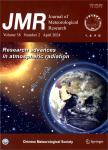Estimation of the Threshold Friction Velocities over Various Dust Storm Source Areas in Northwest China
Estimation of the Threshold Friction Velocities over Various Dust Storm Source Areas in Northwest China作者机构:Department of Atmospheric and Oceanic SciencesSchool of PhysicsPeking University
出 版 物:《Acta meteorologica Sinica》 (ACTA METEOROLOGICA SINICA)
年 卷 期:2010年第24卷第5期
页 面:548-557页
核心收录:
学科分类:07[理学] 070601[理学-气象学] 0706[理学-大气科学]
基 金:Supported by the National Natural Science Foundation of China under Grant Nos.41075005 and 40775013 the "973" National Key Basic Research Program of China under Grant No.2010CB428501 the R&D Special Fund for Public Welfare (meteorology) by the Ministry of Finance Ministry of Science and Technology of China under Grant No.GYHY200806007 the National Basic Research and Development Program under Grant No.2006AA06A306
主 题:dust storm dust rising threshold friction velocity Hunshandake desert area Loess Plateau Gobi desert area
摘 要:The emission of dust particles into the atmosphere is governed by the aerodynamic and resistant factors, which are quantified by the friction velocity u. and the threshold friction velocity u*t, respectively. The threshold friction velocity u*t influences the vertical dust flux and dust transport. Based on the micro-meteorological data obtained in the springs of 2004 and 2006 over Hunshandake desert area, Loess Plateau, and Gobi desert area, the relationship between dust concentration and friction velocity for the dust events that occurred over Hunshandake desert area was investigated, and the threshold friction velocities over the three different dust source areas were estimated. The results show that the value of dust concentration is low during the pre-emission stage of a dust storm event, and the rapid increase of friction velocity provides favor-able dynamic conditions for dust emission. During the dust emission stage, the dust concentration increases sharply due to mechanical and thermal turbulent mixing. At the calm-down stage, the dust concentration drops nearly linearly with the decreasing friction velocity, on account of the gravitational deposition of larger dust particles. When the dust concentration is higher than 200 μgm-3, it is considered as a dust emission process. According to the criteria, the values of threshold friction velocity over Hunshandake desert area and Gobi region are 0.6 and 0.45 m s-1, respectively. The threshold friction velocity over Loess Plateau depends on the wind direction, due to the complex terrain and inhomogeneous surface. The northwest wind shows the effects of the Mu Us desert in the northwest. The corresponding u*t is 0.35 m s-1. The south wind exhibits the characteristics of the Loess hilly dunes in the south, and the u*t is 0.7 m s-1. The large roughness length of the Loess hilly dunes and the large inter-particle cohesion for the clay soil texture increases the local friction velocity. Different threshold friction velo



